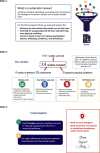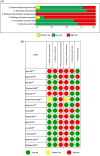Self-directed self-management interventions to prevent or address distress in young people with long-term physical conditions: A rapid review
- PMID: 37533152
- PMCID: PMC10632640
- DOI: 10.1111/hex.13845
Self-directed self-management interventions to prevent or address distress in young people with long-term physical conditions: A rapid review
Abstract
Background: Comorbid distress in adolescents and young adults with physical long-term conditions (LTCs) is common but can be difficult to identify and manage. Self-directed self-management interventions to reduce distress and improve wellbeing may be beneficial. It is unknown, however, which intervention characteristics are successful in supporting young people. This rapid review aimed to identify characteristics of self-directed self-management interventions that aimed, in whole or part, to address distress, wellbeing or self-efficacy in this population.
Methods: A systematic search was conducted for relevant controlled studies in six databases. Data on study settings, population, intervention characteristics, outcome measures, process measures and summary effects were extracted. The risk of bias was assessed using the Cochrane Risk of Bias tool v1, and the strength of evidence was rated (informed by Grading of Recommendations, Assessment, Development and Evaluations). Patient and public involvement members supported the review process, including interpretation of results. The rapid review was registered with PROSPERO (ID: CRD42021285867).
Results: Fourteen studies were included, all of which were randomised trials. Heterogeneity was identified in the health conditions targeted; type of intervention; outcome measures; duration of intervention and follow-up. Three had distress, wellbeing or self-efficacy as their primary outcome. Four modes of delivery were identified across interventions-websites, smartphone applications, text messages and workbooks; and within these, 38 individual components. Six interventions had a significant benefit in mental health, wellbeing or self-efficacy; however, intervention characteristics were similar for beneficial and non-beneficial interventions.
Conclusions: There is a paucity of interventions directly targeting distress and wellbeing in young people with physical LTCs. In those identified, the heterogeneity of interventions and study design makes it difficult to identify which characteristics result in positive outcomes. We propose the need for high-quality, evidence-based self-management interventions for this population; including (1) more detailed reporting of intervention design, content and delivery; (2) robust process evaluation; (3) a core outcome set for measuring mental health and wellbeing for self-management interventions and (4) consistency in follow up periods.
Public contribution: Seven young people with an LTC were involved throughout the rapid review, from the development of the review protocol where they informed the focus and aims, with a central role in the interpretation of findings.
Keywords: adolescents; chronic disease; distress; mental health; rapid review; self-management; young adults.
© 2023 The Authors. Health Expectations published by John Wiley & Sons Ltd.
Conflict of interest statement
Carolyn A. Chew‐Graham has a working role within the
Figures



Similar articles
-
Beyond the black stump: rapid reviews of health research issues affecting regional, rural and remote Australia.Med J Aust. 2020 Dec;213 Suppl 11:S3-S32.e1. doi: 10.5694/mja2.50881. Med J Aust. 2020. PMID: 33314144
-
Behavioural interventions for type 2 diabetes: an evidence-based analysis.Ont Health Technol Assess Ser. 2009;9(21):1-45. Epub 2009 Oct 1. Ont Health Technol Assess Ser. 2009. PMID: 23074526 Free PMC article.
-
The future of Cochrane Neonatal.Early Hum Dev. 2020 Nov;150:105191. doi: 10.1016/j.earlhumdev.2020.105191. Epub 2020 Sep 12. Early Hum Dev. 2020. PMID: 33036834
-
Psychological interventions to improve self-management of type 1 and type 2 diabetes: a systematic review.Health Technol Assess. 2020 Jun;24(28):1-232. doi: 10.3310/hta24280. Health Technol Assess. 2020. PMID: 32568666 Free PMC article.
-
Telephone interventions for symptom management in adults with cancer.Cochrane Database Syst Rev. 2020 Jun 2;6(6):CD007568. doi: 10.1002/14651858.CD007568.pub2. Cochrane Database Syst Rev. 2020. PMID: 32483832 Free PMC article.
References
-
- Saunders B. ‘It seems like you're going around in circles’: recurrent biographical disruption constructed through the past, present and anticipated future in the narratives of young adults with inflammatory bowel disease. Sociol Health Illn. 2017;39(5):726‐740. 10.1111/1467-9566.12561 - DOI - PubMed
Publication types
MeSH terms
LinkOut - more resources
Full Text Sources

